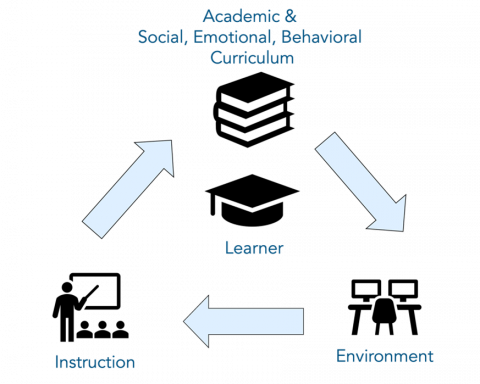In a multi-tiered system of supports (MTSS), a well-designed system of interventions can help provide additional academic, behavioral, and/or social-emotional support that many students need to be successful. But what do you do when students don’t respond to your interventions? Where as Tier 2 interventions, delivered with fidelity, will work for many students, some students will continue to need more. For these students who don’t respond to Tier 2 implemented with fidelity, you’ll need a system for individualizing and adapting interventions that allow you to evaluate the needs of the student, as well as the features of your instructional system to promote learning.
Your first step is collecting diagnostic data to help identify student skill gaps that can be targeted during intervention, as well as areas of strength that can be leveraged to increase student success. The goal is to better understand why the student is not responding to interventions and to design a more individualized level of support that pinpoints the student’s instructional needs. But it’s important to note that learning does not occur in isolation. Rather, as illustrated in Figure 1, learning occurs as an interaction between the learner and their instructional system, which includes the domains of instruction (how we teach), the curriculum (what we teach), and the environment (where we teach). While all students can be successful given the right balance between these domains, it’s important to recognize that this balance is not the same for all students. For example, some students may only need 3-5 practice opportunities to learn a particular new skill, while others require upwards of 100 or more practice opportunities. When designing effective programming for students who have not responded to your interventions, the goal is to find and deliver the right balance of instruction, curriculum, and environmental supports.
Figure 1. Interaction Among Instruction, Curriculum, and Environment to Support the Learner

Alterable Variables Within Each Domain
Instruction (How you teach) Intensifying or adapting instruction is one of the most powerful actions you can take to increase student learning. In addition to its large impact on student success, it is one of the areas that educators have the most control over. When looking to intensify and individualize supports for students who are not responding to interventions, consider the following high-leverage practices that can be intensified:
- Opportunities to respond – Is the student receiving frequent opportunities to respond (OTR’s) including verbal, written and action responses, across classes and content areas? Increase the number of practice opportunities to help firm up student learning.
- Corrective feedback – Are student errors corrected immediately in a straightforward and non-judgmental way? Closely monitor student responses to help you identify student errors as they happen. Provide clear, consistent corrections to help reduce mislearning.
- Explicit instruction – Is there a clear instructional sequence that provides teacher modeling of new skills followed by guided practice and independent practice (i.e., I do, we do, you do)? Ensure teacher modeling is clear with minimal teacher talk. Increase guided practice to better scaffold instruction and help students gradually become independent.
Curriculum (What you teach) Students bring different levels of background knowledge and skill to the classroom. Make sure you are teaching the right skills in a timely manner, by considering the following:
- Scope and sequence – Is there a clear scope and sequence that is conducive to student learning? Ensure that prerequisite skills or background knowledge are taught before teaching higher level skills. For example, before teaching a student how to decode simple words, ensure they know each of the individual letters sounds.
- Level of difficulty – Is the level of difficulty at an appropriate level that is not too hard and not too easy? Focus on content that builds on prior knowledge but provides scaffolds to accelerate student learning.
- Instructional match – Is the instructional focus matched to the specific needs of the student (consider these example reading and math lessons)? Use your diagnostic data to determine the specific skills that students need and use evidence-based programs and strategies that target those skills. Program placement tests can also help you find the right fit.
Environment (Where you teach) The instructional environment can either facilitate learning or hinder it. Some students will require a quiet, still learning environment in order to focus their attention, while other students can thrive in a noisier classroom with more activity. Examine the following variables to help provide an environment conducive to learning:
- Clearly taught expectations – Have classroom and school expectations been clearly communicated to students? Teach and reinforce routines and expectations for how to learn and interact with other students and adults. This allows students to focus their cognitive energy on learning the content and creates an effective learning environment.
- Positive interactions – Does the student have frequent positive interactions with adults and other students? Provide a 5:1 ratio of positive to corrective feedback to ensure students feel valued and welcomed in the classroom.
- Physical setup – Is the classroom set up in a way that allows students to focus on learning and interact with others in a positive way? Ensure your classroom setup allows students to easily see and hear the teacher, move freely, and collaborate with peers.
Tips for Success!
Make it a Match. No single solution will work for all students. When students aren’t responding to your interventions, collect data across the multiple domains to answer the specific questions you have:
- Is this student getting enough corrective feedback?
- Do we need to increase student motivation?
Implement solutions that match the specific instruction, curriculum, and environmental need(s) of the student.
Provide Opportunities Across the Day. Changing the alterable variables within an intervention period is a good start, but students who aren’t responding to interventions need comprehensive support. Think creatively for intensifying instruction, curriculum, and environmental supports across the day. This can include finding small pockets of free time throughout the day, using consistent routines across class periods to ensure alignment, and increasing communication between staff members providing support.
Practice, Practice, Practice. When you’re stuck and don’t know where else to start, increasing student opportunities to respond and corrective feedback is a great first step in intensifying interventions. This can be done by increasing the intervention time, decreasing the group size to give more individual practice opportunities, building in more practice opportunities across the day, or reducing teacher talk and increasing your instructional pace.
Fidelity is Key. Before intensifying and adapting interventions, be sure to check that the intervention was delivered with fidelity:
- If fidelity is low (e.g., less than 80%), then improve fidelity and continue providing the intervention.
- If fidelity is high (e.g., above 80%), then check to see who the intervention is working for and who it is not.
- If the majority of students are benefiting from the intervention, then focus on the students who aren’t responding and make individuals adaptations.
- If the intervention is not working for the majority of students, consider instructional intensification of the intervention that would benefit all of the students.
